Immobilization of Collagen on the Surface of a PEEK Implant with Monolayer Nanopores
Abstract
:1. Introduction
2. Materials and Methods
2.1. Materials
2.2. Surface Treatment of PEEK Implants Using Mixed Acids under Ultrasound
2.3. Measurement of Pore Size and Pore Layer Thickness of PEEK Implant Surface
2.4. Measurement of Tensile and Compressive Strength of Porous PEEK Implants
2.5. Covalent Bonding of Collagen on Porous PEEK Implant
2.6. Elemental Composition of PEEK Implant Surface by XPS
2.7. Cell Attachment on the Porous PEEK Implant Surface
2.8. Alizarin Red and Alkaline Phosphatase Staining
2.9. In Vitro Cytotoxicity of Porous PEEK Implant
3. Results
3.1. Formation of Single-Layered Nanopores on the Surface of PEEK Implants
3.2. Relationship between Surface Porosity and Mechanical Properties
3.3. Immobilization of Collagen on Porous PEEK Implant Surface
3.4. MC3T3-E1 Cell Behavior on PEEK Implants with Nanopores on the Surface
3.5. In Vitro Cytotoxicity of Porous PEEK Implant
4. Discussion
Author Contributions
Funding
Institutional Review Board Statement
Informed Consent Statement
Data Availability Statement
Acknowledgments
Conflicts of Interest
References
- Carmine, T.K.; Wang, S.; Li, X.; Zhu, D. Orthopedic implants and devices for bone fractures and defects: Past, present and perspective. Eng. Regen. 2020, 1, 6–18. [Google Scholar]
- Li, J.; Li, Z.; Li, R.; Shi, Y.; Wang, H.; Wang, Y.; Jin, G. In vitro and in vivo evaluations of mechanical properties, biocompatibility and osteogenic ability of sintered porous titanium alloy implant. RSC Adv. 2018, 8, 36512–36520. [Google Scholar] [CrossRef] [Green Version]
- Katzer, A.; Marquardt, H.; Westendorf, J.; Wening, J.V.; von Foerster, G. Polyetheretherketone–cytotoxicity and mutagenicity in vitro. Biomaterials 2002, 23, 1749–1759. [Google Scholar] [CrossRef]
- Godara, A.; Raabe, D.; Green, S. The influence of sterilization processes on the micromechanical properties of carbon fiber-reinforced PEEK composites for bone implant applications. Acta Biomater. 2007, 3, 209–220. [Google Scholar] [CrossRef]
- Gu, X.; Sun, X.; Sun, Y.; Wang, J.; Liu, Y.; Yu, K.; Wang, Y.; Zhou, Y. Bioinspired modifications of PEEK implants for bone tissue engineering. Front. Bioeng. Biotechnol. 2020, 8, 631616. [Google Scholar] [CrossRef]
- Yabutsuka, T.; Fukushima, K.; Hiruta, T.; Takai, S.; Yao, T. Fabrication of bioactive fiber-reinforced PEEK and MXD6 by incorporation of precursor of apatite. J. Biomed. Mater. Res. Part B Appl. Biomater. 2018, 106, 2254–2265. [Google Scholar] [CrossRef]
- Yuan, B.; Cheng, Q.; Zhao, R.; Zhu, X.; Yang, X.; Yang, X.; Zhang, K.; Song, Y.; Zhang, X. Comparison of osteointegration property between PEKK and PEEK: Effects of surface structure and chemistry. Biomaterials 2018, 170, 116–126. [Google Scholar] [CrossRef]
- Hahn, B.-D.; Park, D.-S.; Choi, J.-J.; Ryu, J.; Yoon, W.-H.; Choi, J.-H.; Kim, J.-W.; Ahn, C.-W.; Kim, H.-E.; Yoon, B.-H.; et al. Osteoconductive hydroxyapatite coated PEEK for spinal fusion surgery. Appl. Surf. Sci. 2013, 283, 6–11. [Google Scholar] [CrossRef]
- Wong, K.I.; Zhong, Y.; Li, D.; Cheng, Z.; Yu, Z.; Wei, M. Modified porous microstructure for improving bone compatibility of polyetheretherketone. J. Mech. Behav. Biomed. Mater. 2021, 120, 104541. [Google Scholar] [CrossRef]
- Ouyang, L.; Zhao, Y.; Jin, G.; Lu, T.; Li, J.; Qiao, Y.; Ning, C.; Zhang, X.; Chu, P.K.; Liu, X. Influence of sulfur content on bone formation and antibacterial ability of sulfonated PEEK. Biomaterials 2016, 83, 115–126. [Google Scholar] [CrossRef]
- Landy, B.C.; VanGordon, S.B.; McFetridge, P.S.; Sikavitsas, V.I.; Jarman-Smith, M. Mechanical and in vitro investigation of a porous PEEK foam for medical device implants. J. Appl. Biomater. Funct. Mater. 2012, 11, 35–44. [Google Scholar] [CrossRef] [PubMed]
- Garot, C.; Bettega, G.; Picart, C. Additive manufacturing of material scaffolds for bone regeneration: Toward application in the clinics. Adv. Funct. Mater. 2020, 31, 2006967. [Google Scholar] [CrossRef] [PubMed]
- Lou, H.-Y.; Zhao, W.; Zeng, Y.; Cui, B. The role of membrane curvature in nanoscale topography-induced intracellular signaling. Acc. Chem. Res. 2018, 51, 1046–1053. [Google Scholar] [CrossRef] [PubMed]
- Zhu, L.; Luo, D.; Liu, Y. Effect of the nano/microscale structure of biomaterial scaffolds on bone regeneration. Int. J. Oral Sci. 2020, 12, 6. [Google Scholar] [CrossRef] [Green Version]
- Kwon, G.; Kim, H.; Gupta, K.C.; Kang, I.-K. Enhanced tissue compatibility of polyetheretherketone disks by dopamine-mediated protein immobilization. Macromol. Res. 2018, 26, 128–138. [Google Scholar] [CrossRef]
- Du, Y.; Zhang, L.; Ye, X.; Nie, H.; Hou, Z.; Zeng, T.; Sun, Y.; Yan, G.; Shang, P. In vitro and in vivo evaluation of bone morphogenetic protein-2 (BMP-2) immobilized collagen-coated polyetheretherketone (PEEK). Front. Mater. Sci. China 2015, 9, 38–50. [Google Scholar] [CrossRef]
- Wang, W.; Luo, C.J.; Huang, J.; Edirisinghe, M. PEEK surface modification by fast ambient-temperature sulfonation for bone implant applications. J. R. Soc. Interface 2019, 16, 20180955. [Google Scholar] [CrossRef] [PubMed] [Green Version]
- Santos, F.S.F.; Vieira, M.; Silva, H.N.; Tomás, H.; Fook, M.V.L. Surface bioactivation of polyether ether ketone (PEEK) by sulfuric acid and piranha solution: Influence of the modification route in capacity for inducing cell growth. Biomolecules 2021, 11, 1260. [Google Scholar] [CrossRef]
- Ding, R.; Chen, T.; Xu, Q.; Wei, R.; Feng, B.; Weng, J.; Duan, K.; Wang, J.; Zhang, K.; Zhang, X. Mixed modification of the surface microstructure and chemical state of polyetheretherketone to improve its antimicrobial activity, hydrophilicity, cell adhesion, and bone integration. ACS Biomater. Sci. Eng. 2020, 6, 842–851. [Google Scholar] [CrossRef]
- Wang, H.; Zhou, W.; Li, P. Focused ion beam assisted interface detection for fabricating functional plasmonic nanostructures. J. Nanomater. 2015, 2015, 468069. [Google Scholar] [CrossRef] [Green Version]
- García-Domínguez, A.; Claver, J.; Camacho, A.M.; Sebastián, M.A. Considerations on the applicability of test methods for mechanical characterization of materials manufactured by FDM. Materials 2020, 13, 28. [Google Scholar] [CrossRef] [PubMed] [Green Version]
- Kim, C.-S.; Jung, K.-H.; Kim, H.; Kim, C.-B.; Kang, I.-K. Collagen-grafted porous HDPE/PEAA scaffolds for bone reconstruction. Biomater. Res. 2016, 20, 23. [Google Scholar] [CrossRef] [PubMed] [Green Version]
- Ryu, J.H.; Messersmith, P.B.; Lee, H. Polydopamine surface chemistry: A decade of discovery. ACS Appl. Mater. Interfaces 2018, 10, 7523–7540. [Google Scholar] [CrossRef]
- Fu, C.; Bai, H.; Hu, Q.; Gao, T.; Bai, Y. Enhanced proliferation and osteogenic differentiation of MC3T3-E1 pre-osteoblasts on graphene oxide-impregnated PLGA–gelatin nanocomposite fibrous membranes. RSC Adv. 2017, 7, 8886–8897. [Google Scholar] [CrossRef] [Green Version]
- Jokinen, J.; Dadu, E.; Nykvist, P.; Kapyla, J.; White, D.J.; Ivaska, J.; Vehviläinen, P.; Reunanen, H.; Larjava, H.; Häkkinen, L.; et al. Integrin-mediated cell adhesion to type I collagen fibrils. J. Biol. Chem. 2004, 279, 31956–31963. [Google Scholar] [CrossRef] [Green Version]
- Shen, C.; Yang, C.; Xu, S.; Zhao, H. Comparison of osteogenic differentiation capacity in mesenchymal stem cells derived from human amniotic membrane (AM), umbilical cord (UC), chorionic membrane (CM), and decidua (DC). Cell Biosci. 2019, 9, 17. [Google Scholar] [CrossRef]
- Feng, X.; Ma, L.; Liang, H.; Xiaoming, L.; Jie, L.; Wenqiang, L.; Kun, W.; Yu, S.; Bingjin, W.; Gaocai, L.; et al. Osteointegration of 3D-Printed Fully Porous Polyetheretherketone Scaffolds with Different Pore Sizes. ACS Omega 2020, 5, 26655–26666. [Google Scholar] [CrossRef]
- Su, Y.; He, J.; Jiang, N.; Zhang, H.; Wang, L.; Liu, X.; Li, D.; Yin, Z. Additively-manufactured poly-ether-ether-ketone (PEEK) lattice scaffolds with uniform microporous architectures for enhanced cellular response and soft tissue adhesion. Mater. Des. 2020, 191, 108671. [Google Scholar] [CrossRef]
- Torstrick, F.B.; Evans, N.T.; Stevens, H.Y.; Gall, K.; Guldberg, R.E. Do surface porosity and pore size influence mechanical properties and cellular response to PEEK? Clin. Orthop. Relat. Res. 2016, 474, 2373–2383. [Google Scholar] [CrossRef] [Green Version]
- Sagomonyants, K.B.; Jarman-Smith, M.L.; Devine, J.N.; Aronow, M.S.; Gronowicz, G.A. The in vitro response of human osteoblasts to polyetheretherketone (PEEK) substrates compared to commercially pure titanium. Biomaterials 2008, 29, 1563–1572. [Google Scholar] [CrossRef]
- Wu, J.; Li, L.; Fu, C.; Yang, F.; Jiao, Z.; Shi, X.; Ito, Y.; Wang, Z.; Liu, Q.; Zhang, P. Micro-porous polyetheretherketone implants decorated with BMP-2 via phosphorylated gelatin coating for enhancing cell adhesion and osteogenic differentiation. Colloids Surf. B Biointerf. 2018, 169, 233–241. [Google Scholar] [CrossRef] [PubMed]
- Baek, J.-Y.; Xing, Z.-C.; Kwak, G.; Yoon, K.-B.; Park, S.-Y.; Park, L.S.; Kang, I.-K. Fabrication and characterization of collagen-immobilized porous PHBV/HA nanocomposite scaffolds for bone tissue engineering. J. Nanomater. 2012, 2012, 171804. [Google Scholar] [CrossRef]
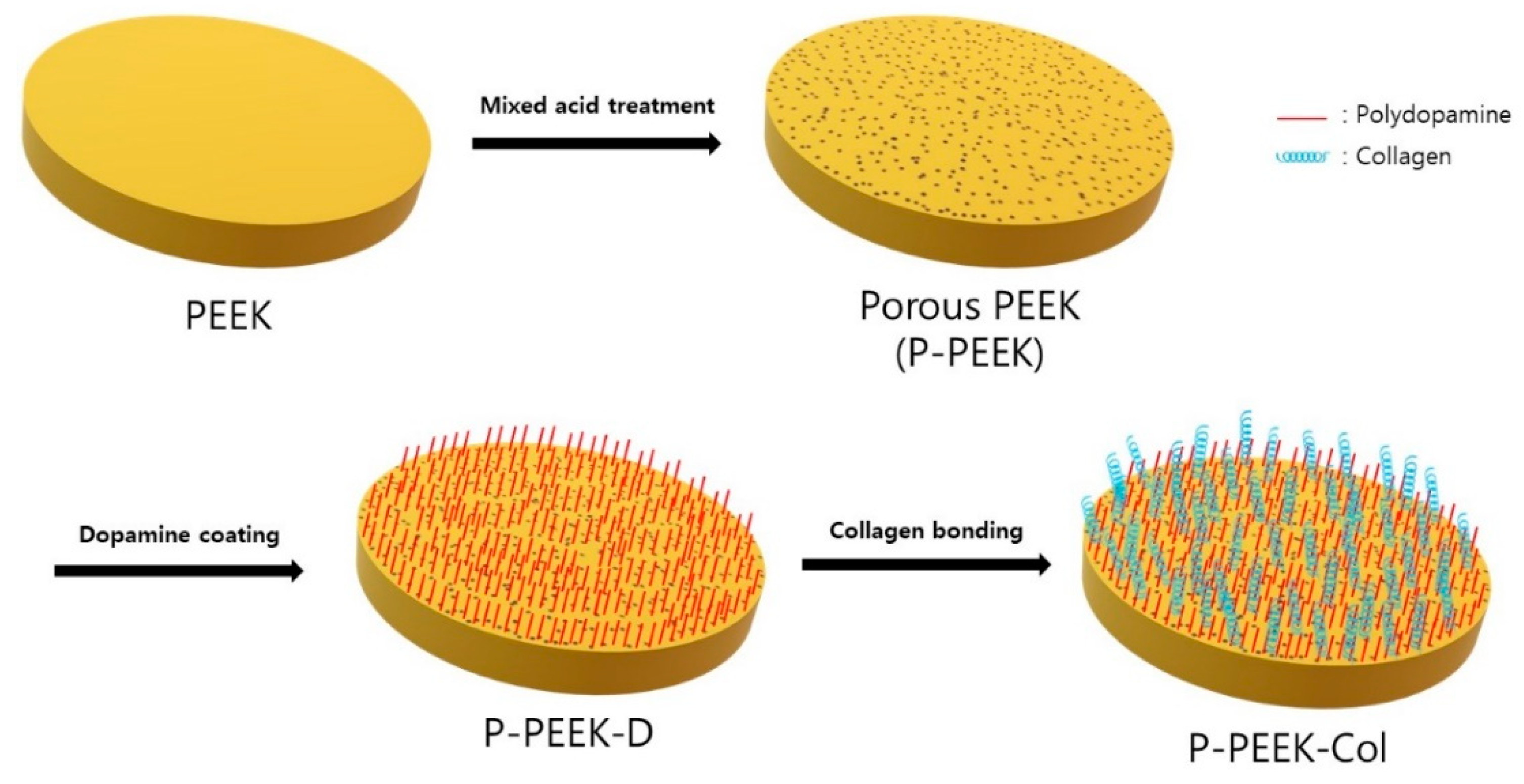
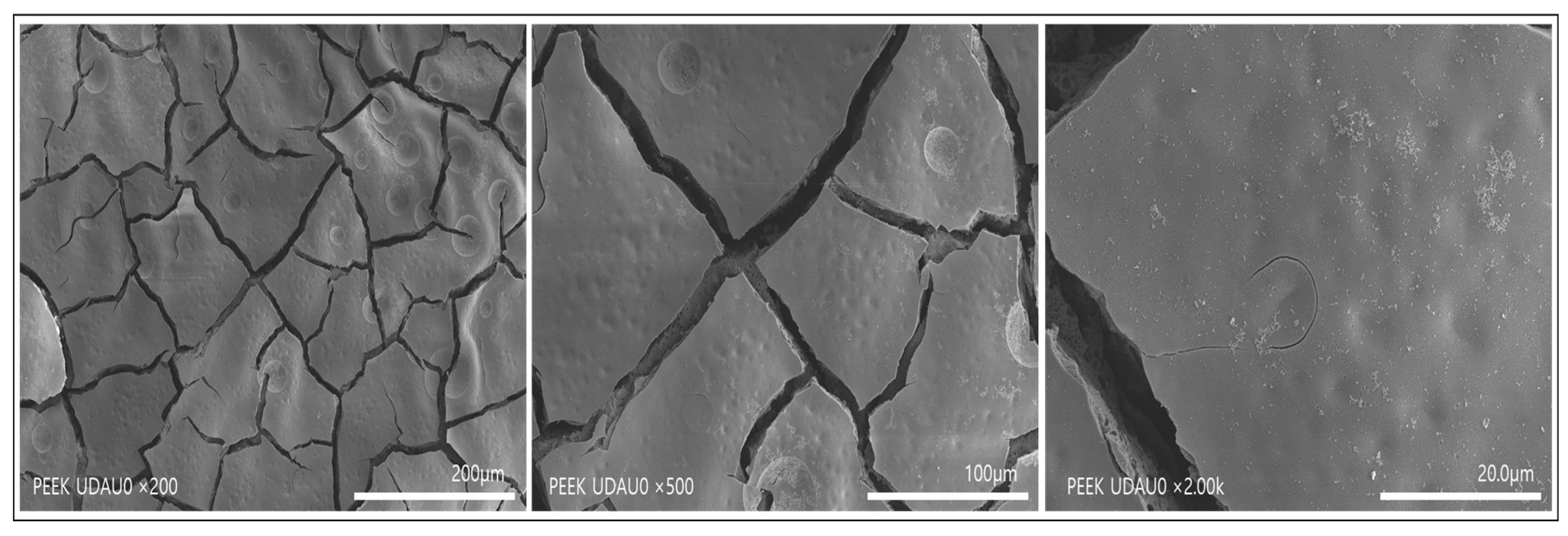
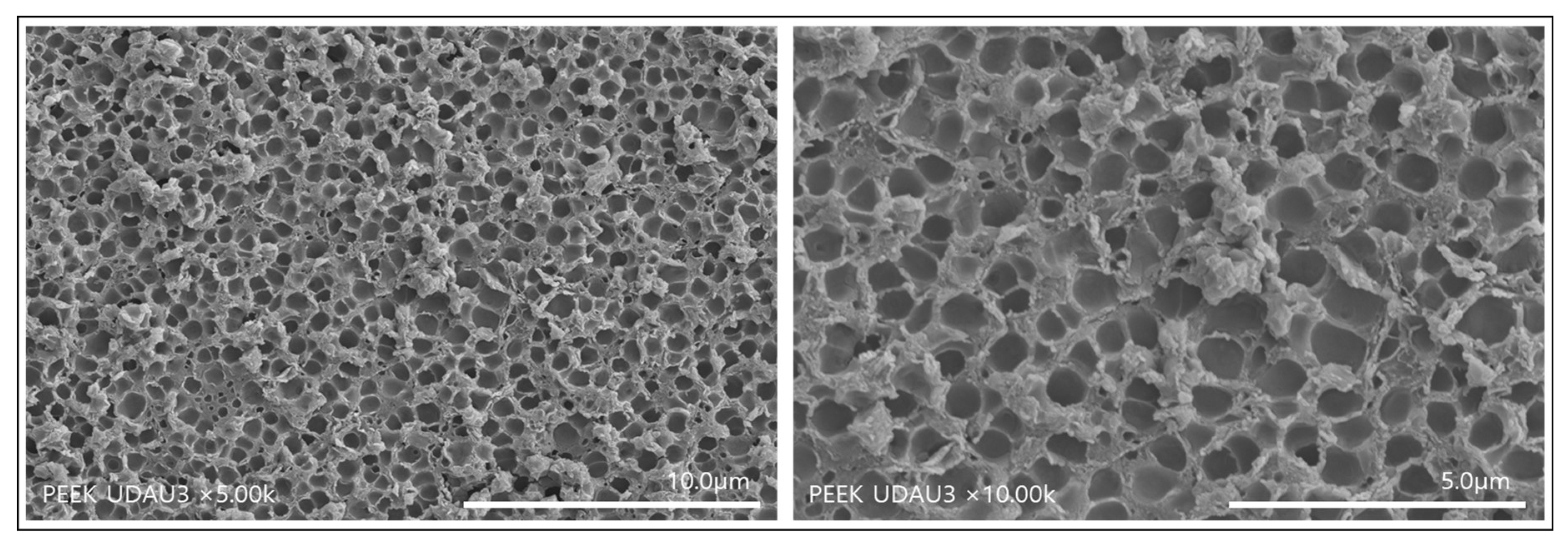
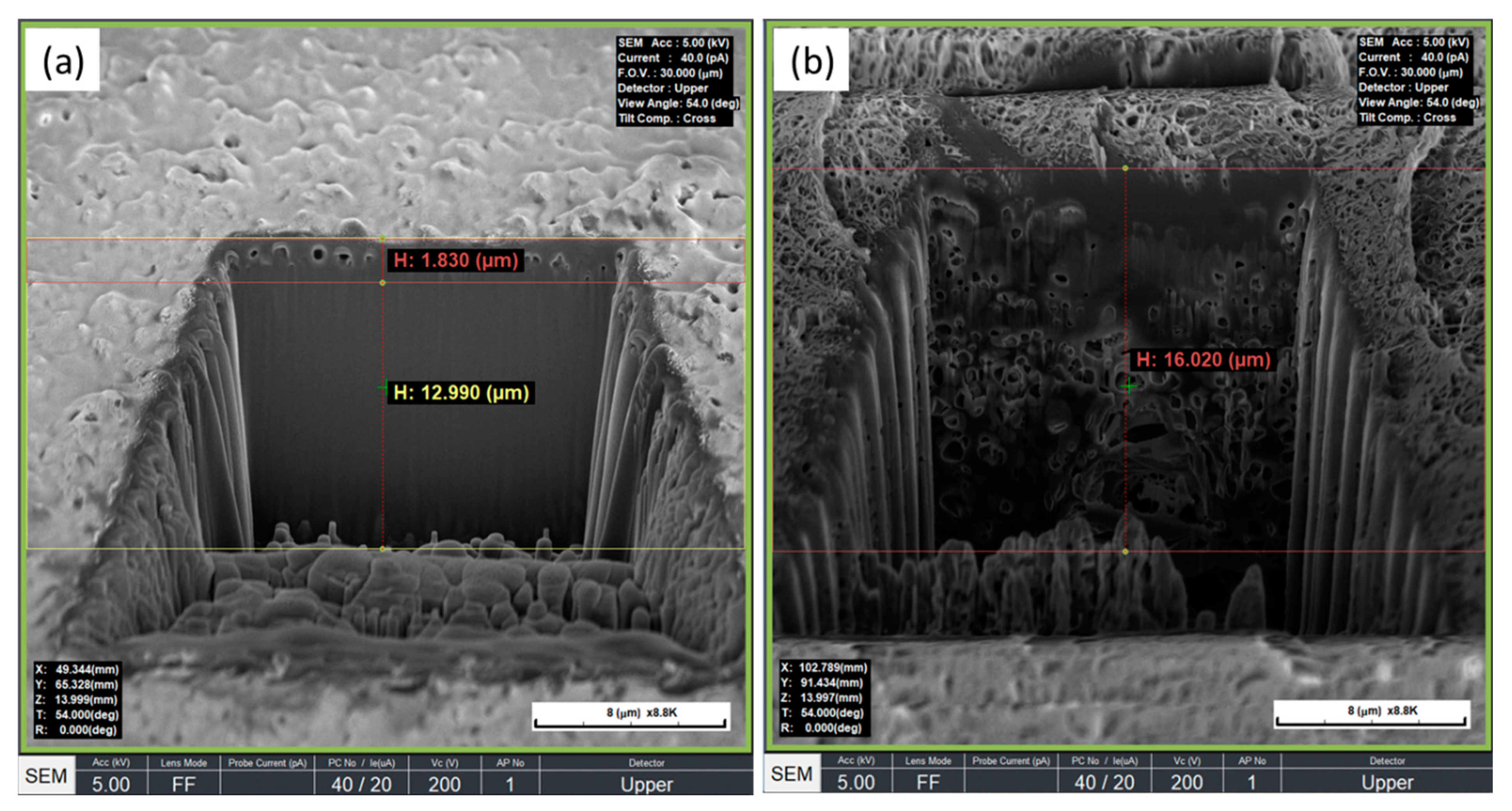
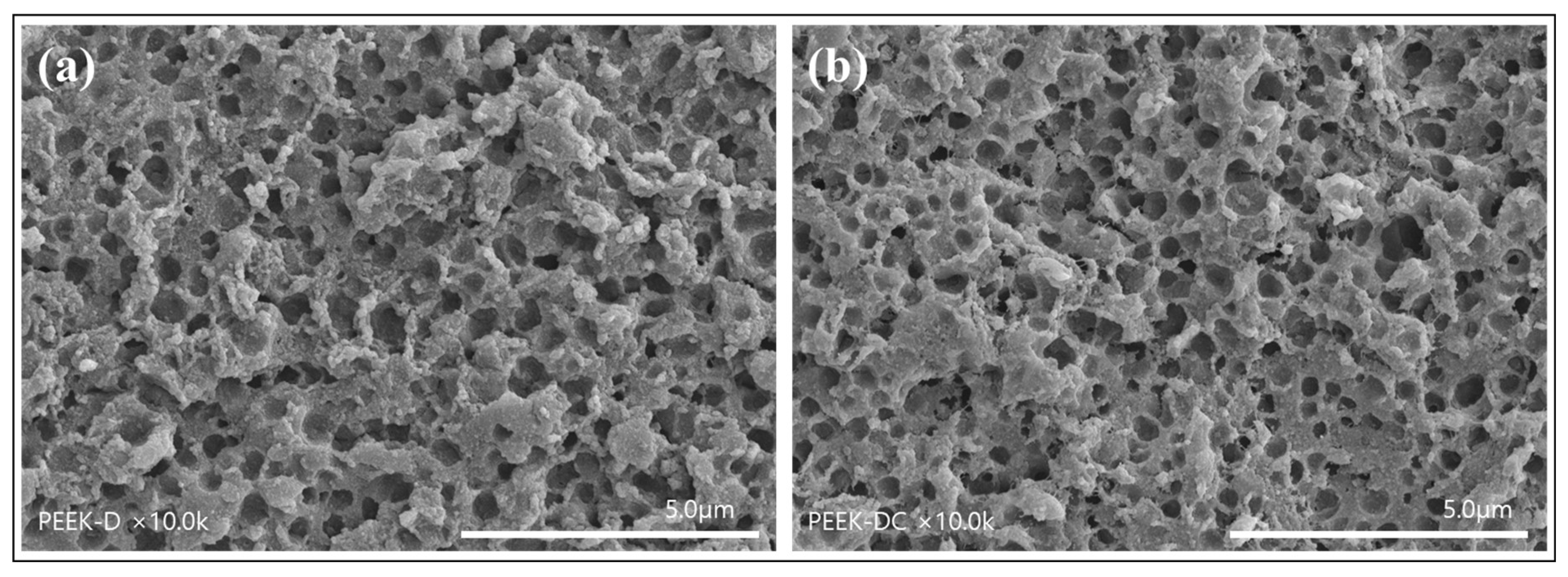
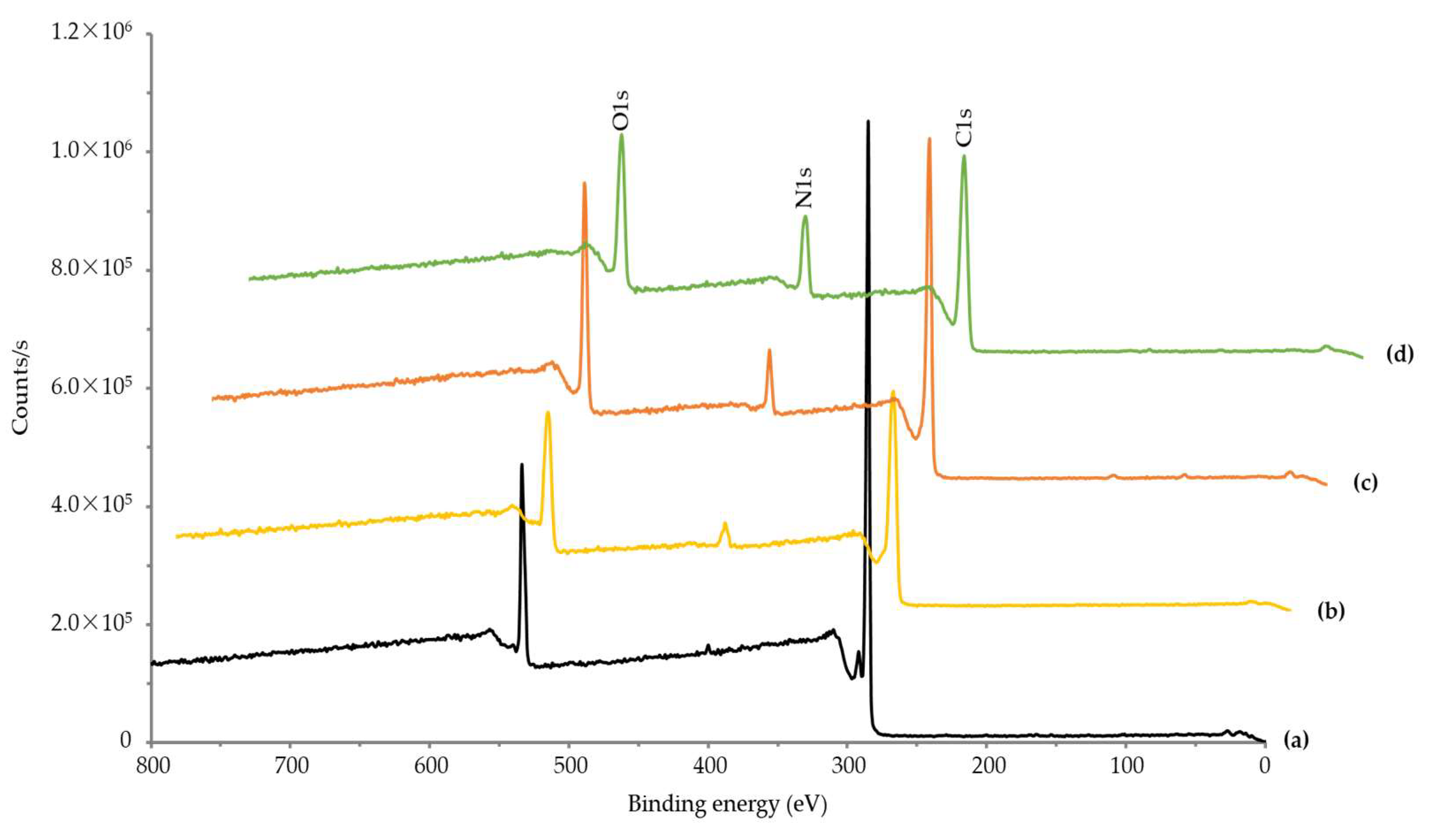
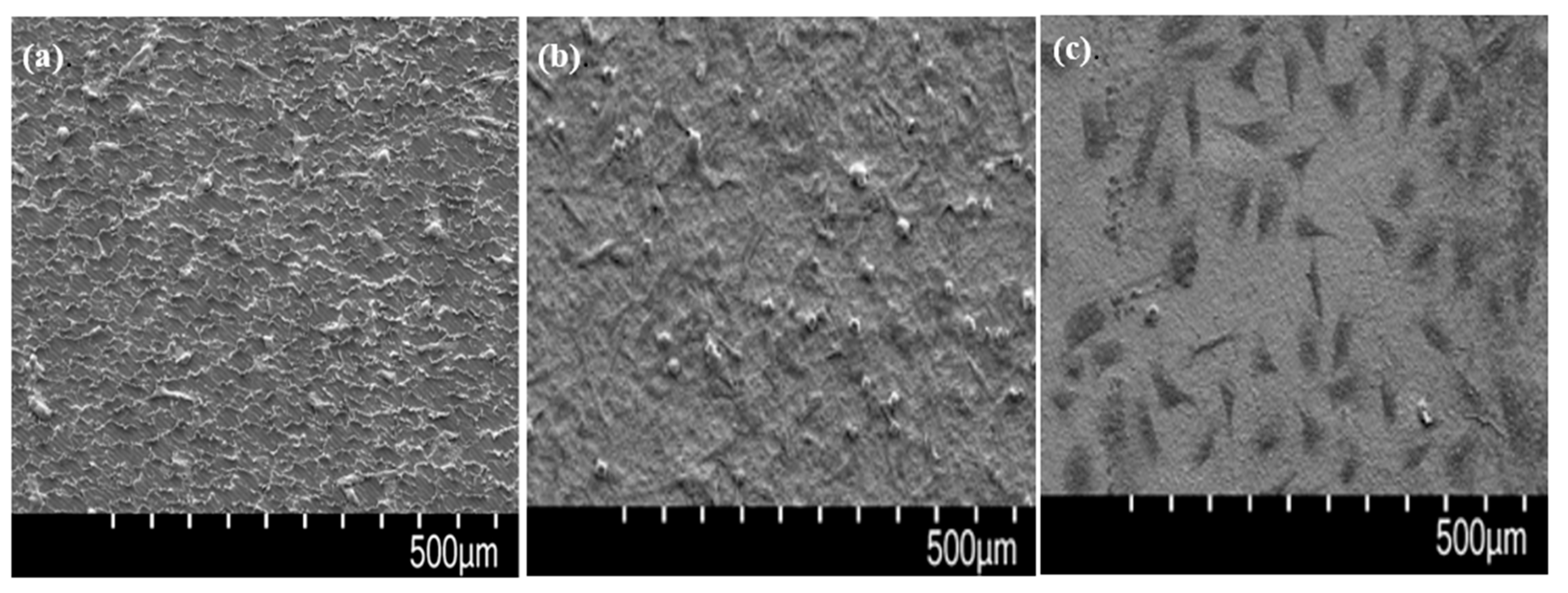
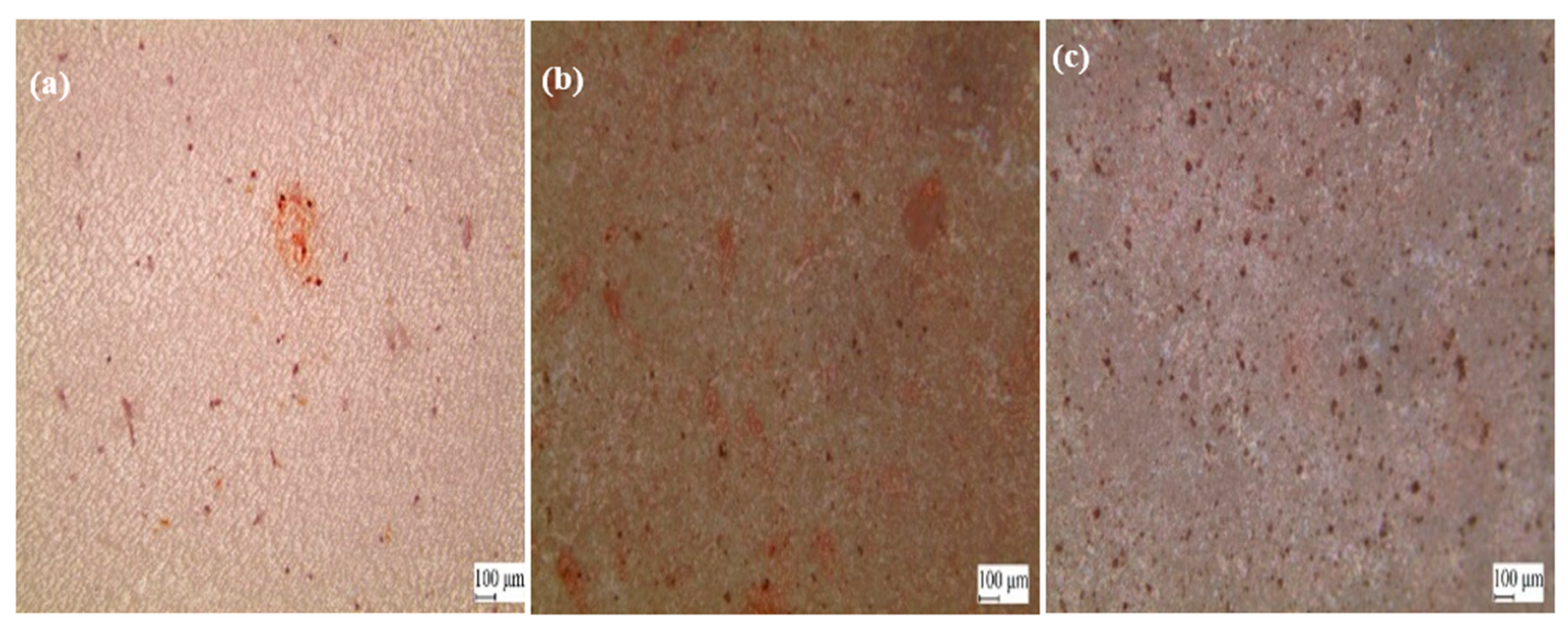
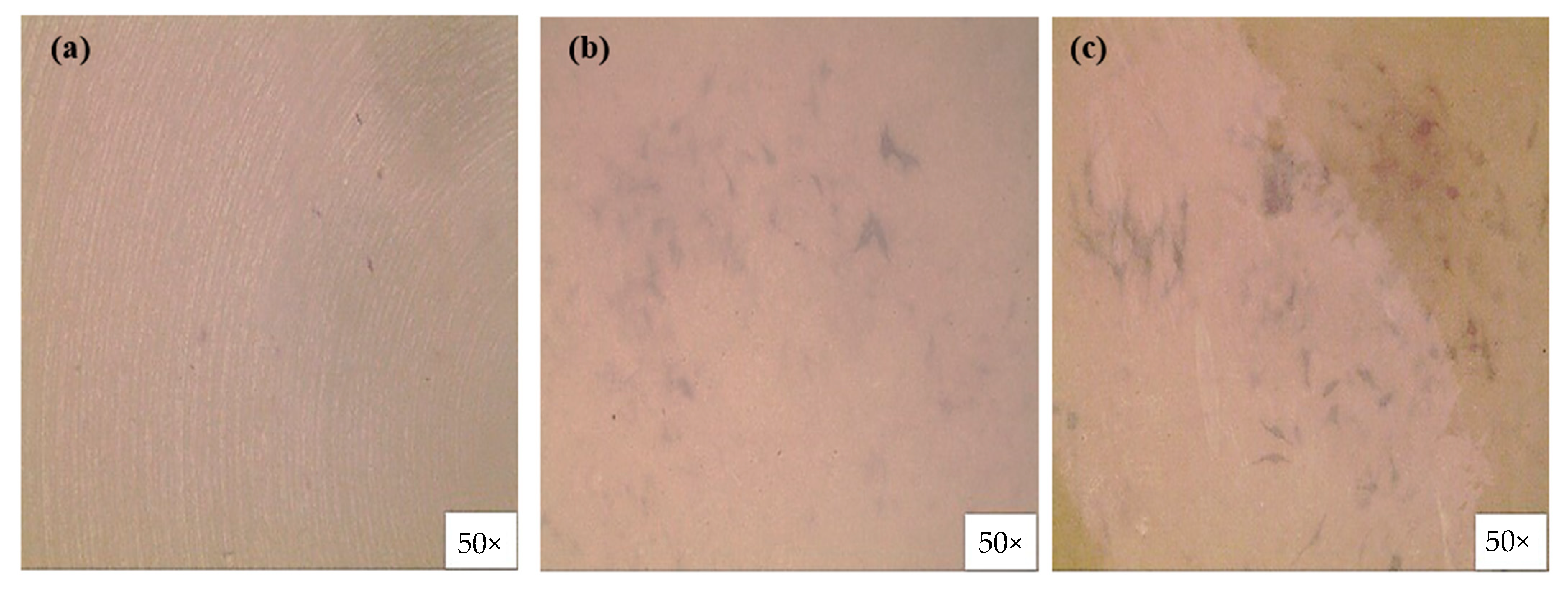
| Samples | Tensile Strength (kgf/mm2) | Compressive Strength (N) |
|---|---|---|
| PEEK | 15.078 ± 0.085 | 15,168.08 ± 0.02 |
| P-PEEK-1 | 14.913 ± 0.200 | 15,130.09 ± 0.10 |
| P-PEEK-2 | 14.976 ± 0.506 | 15,123.93 ± 0.03 |
| P-PEEK-3 | 14.897 ± 0.203 | 15,125.50 ± 0.04 |
| Substrates | Atomic Percent of Elements (%) | |||
|---|---|---|---|---|
| C | O | N | S | |
| PEEK | 84.95 | 14.38 | 0.67 | - |
| P-PEEK | 75.07 | 20.26 | 4.67 | - |
| P-PEEK-D | 71.68 | 19.67 | 8.64 | - |
| P-PEEK-Col | 63.85 | 19.78 | 16.23 | 0.15 |
Publisher’s Note: MDPI stays neutral with regard to jurisdictional claims in published maps and institutional affiliations. |
© 2022 by the authors. Licensee MDPI, Basel, Switzerland. This article is an open access article distributed under the terms and conditions of the Creative Commons Attribution (CC BY) license (https://creativecommons.org/licenses/by/4.0/).
Share and Cite
Kim, H.; Lee, Y.H.; Kim, N.K.; Kang, I.K. Immobilization of Collagen on the Surface of a PEEK Implant with Monolayer Nanopores. Polymers 2022, 14, 1633. https://doi.org/10.3390/polym14091633
Kim H, Lee YH, Kim NK, Kang IK. Immobilization of Collagen on the Surface of a PEEK Implant with Monolayer Nanopores. Polymers. 2022; 14(9):1633. https://doi.org/10.3390/polym14091633
Chicago/Turabian StyleKim, Hun, Yang Ho Lee, Nam Kwon Kim, and Inn Kyu Kang. 2022. "Immobilization of Collagen on the Surface of a PEEK Implant with Monolayer Nanopores" Polymers 14, no. 9: 1633. https://doi.org/10.3390/polym14091633
APA StyleKim, H., Lee, Y. H., Kim, N. K., & Kang, I. K. (2022). Immobilization of Collagen on the Surface of a PEEK Implant with Monolayer Nanopores. Polymers, 14(9), 1633. https://doi.org/10.3390/polym14091633







